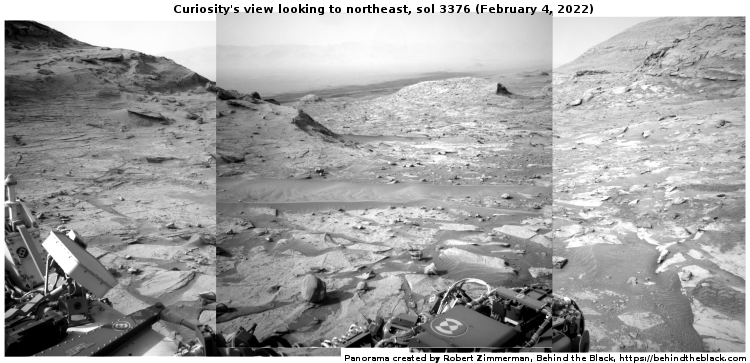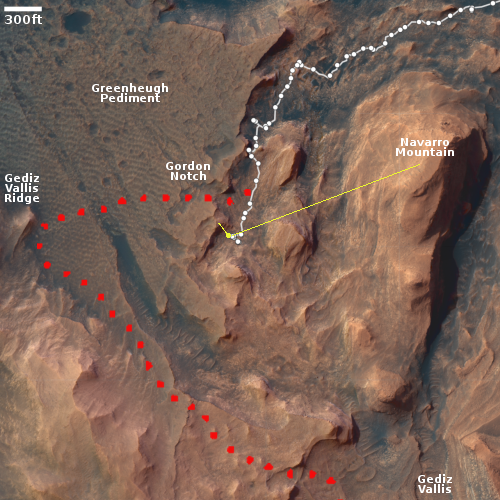Alien and barren Mars

Click for full resolution. Click here, here, and here for original images.
Cool image time! The panorama above was created from three photos downloaded today from Curiosity’s right navigation camera. It looks to the northeast of the rover, out across Gale Crater. The crater floor is about 1,750 feet lower.
This is dust season on Mars, which explains the thick haze in the crater. About 25 miles away the crater rim can be faintly seen through the dust haze as a mountain chain. If you look at the full resolution panorama you can see several buttes on the crater floor barely visible through that haze.
The map to the right gives the context. Curiosity’s present location is indicated by the yellow dot, with the yellow lines indicating the area covered by the panorama. The red dotted line indicates the rover’s future planned route.
For the last few weeks Curiosity has been working nestled to the base of a small butte the science team has dubbed “The Prow”, studying its numerous thin layers. I featured the Prow in this January 11th post, though at the time I overestimated its size, which is only about ten feet high. The butte is especially fascinating in that its top layers overhang outward in an unbelievable manner.
The rover is now about to move on, though where must still be decided by the science team. Based on their most recent update it appears they are not ready to leave this barren rocky hollow surrounded with many-layered buttes, and will take the rover to another.
On Christmas Eve 1968 three Americans became the first humans to visit another world. What they did to celebrate was unexpected and profound, and will be remembered throughout all human history. Genesis: the Story of Apollo 8, Robert Zimmerman's classic history of humanity's first journey to another world, tells that story, and it is now available as both an ebook and an audiobook, both with a foreword by Valerie Anders and a new introduction by Robert Zimmerman.
The print edition can be purchased at Amazon or from any other book seller. If you want an autographed copy the price is $60 for the hardback and $45 for the paperback, plus $8 shipping for each. Go here for purchasing details. The ebook is available everywhere for $5.99 (before discount) at amazon, or direct from my ebook publisher, ebookit. If you buy it from ebookit you don't support the big tech companies and the author gets a bigger cut much sooner.
The audiobook is also available at all these vendors, and is also free with a 30-day trial membership to Audible.
"Not simply about one mission, [Genesis] is also the history of America's quest for the moon... Zimmerman has done a masterful job of tying disparate events together into a solid account of one of America's greatest human triumphs."--San Antonio Express-News

Click for full resolution. Click here, here, and here for original images.
Cool image time! The panorama above was created from three photos downloaded today from Curiosity’s right navigation camera. It looks to the northeast of the rover, out across Gale Crater. The crater floor is about 1,750 feet lower.
This is dust season on Mars, which explains the thick haze in the crater. About 25 miles away the crater rim can be faintly seen through the dust haze as a mountain chain. If you look at the full resolution panorama you can see several buttes on the crater floor barely visible through that haze.
The map to the right gives the context. Curiosity’s present location is indicated by the yellow dot, with the yellow lines indicating the area covered by the panorama. The red dotted line indicates the rover’s future planned route.
For the last few weeks Curiosity has been working nestled to the base of a small butte the science team has dubbed “The Prow”, studying its numerous thin layers. I featured the Prow in this January 11th post, though at the time I overestimated its size, which is only about ten feet high. The butte is especially fascinating in that its top layers overhang outward in an unbelievable manner.
The rover is now about to move on, though where must still be decided by the science team. Based on their most recent update it appears they are not ready to leave this barren rocky hollow surrounded with many-layered buttes, and will take the rover to another.
On Christmas Eve 1968 three Americans became the first humans to visit another world. What they did to celebrate was unexpected and profound, and will be remembered throughout all human history. Genesis: the Story of Apollo 8, Robert Zimmerman's classic history of humanity's first journey to another world, tells that story, and it is now available as both an ebook and an audiobook, both with a foreword by Valerie Anders and a new introduction by Robert Zimmerman.
The print edition can be purchased at Amazon or from any other book seller. If you want an autographed copy the price is $60 for the hardback and $45 for the paperback, plus $8 shipping for each. Go here for purchasing details. The ebook is available everywhere for $5.99 (before discount) at amazon, or direct from my ebook publisher, ebookit. If you buy it from ebookit you don't support the big tech companies and the author gets a bigger cut much sooner.
The audiobook is also available at all these vendors, and is also free with a 30-day trial membership to Audible.
"Not simply about one mission, [Genesis] is also the history of America's quest for the moon... Zimmerman has done a masterful job of tying disparate events together into a solid account of one of America's greatest human triumphs."--San Antonio Express-News



Expedition Ares
“When he began writing Expedition Ares in 1948, Germanborn space scientist Krafft Ehricke (1917-1984) had been in the United States for one year, and was living on the U .S. Army base at Ft. Bliss, Texas ….
… Krafft Ehricke became intrigued with space flight in 1929, when, at the age of 1 2 , he saw the Fritz Lang film, Woman in the Moon in a Berlin theater. Two years later, he became aware of the activities of the spunky German Society for Space Travel, but ‘he was too young to join. He continued his studies, however, and in 1 934, at the age of 17, he wrote Thoughts of Space and Man, a collection of short stories about scientific discovery, also yet to be published. …..
….
… Krafft Ehricke believed that a new Renaissance was necessary. Works, such as his Expedition Ares, embody the optimism, the commitment to scientific and technological advancement, and the belief in the irrepressibility of the human spirit, that mankind must marshal today to make this, and other great projects, a reality…”
https://d3n8a8pro7vhmx.cloudfront.net/larouchepac/legacy_url/19477/ehricke_expedition-ares.pdf?1612573682
I’m a bit confused. The large bulbous overhanging cliff you featured in the Jan 11 posting was imaged on Sol 3331. You can see it clearly on your map, just above the second red dot of the planned route. I have searched for the name of this feature, but can not find it – if one exists
In this map update from Sol 3347, citizen cartographer kymani76 included elevations.
http://www.unmannedspaceflight.com/index.php?act=attach&type=post&id=50091
This shows the top of the cliff is ~10 meters high. So I would say your initial height estimate was correct. Also, the slightly curved area of “Prow” is visible SSW of the rover’s position a few meters away.
I understood the “Prow” outcrop to be much smaller, wide area, about one meter in height, several meters south of this cliff. This is where Curiosity has been since Sol 3353.
This update from Sol 3363 shows the area name “Prow” (orange triangle) and “Panari” to the SE. I think the red triangles indicate individual targets of interest and/or photos.
http://www.unmannedspaceflight.com/index.php?act=attach&type=post&id=50256
On Sol 3376 Curiosity moved about 12 meters west, perhaps finally off exploring more.
I apologize if I misunderstood your post and I really appreciate the Martian updates.
This Navcam pano on Sol 3376 by Jan van Driel shows “Prow”, just right of center, very well.
http://www.unmannedspaceflight.com/index.php?act=attach&type=post&id=50357
It’s easy to see how the science team was so enthralled with this multi-layered outcrop.